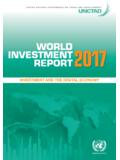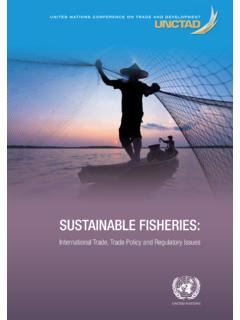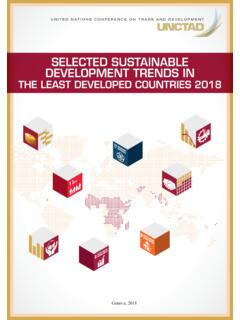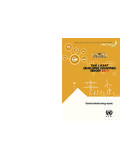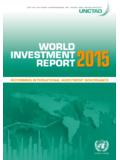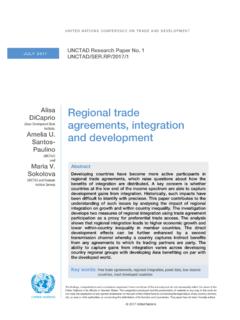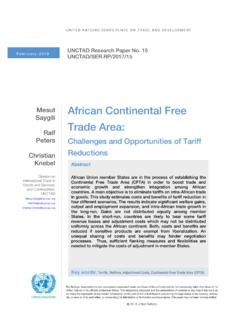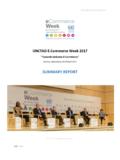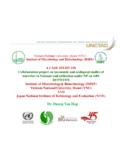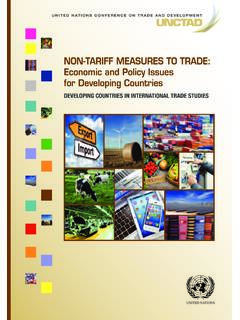Transcription of WORLD INVESTMENT REPORT2014 - UNCTAD | Home
1 UNITED NATIONS conference ON TRADE AND DEVELOPMENTWORLD INVESTMENT REPORT2014 New York and Geneva, 2014 INVESTING IN THE SDGs: AN ACTION PLANW orld INVESTMENT Report 2014: Investing in the SDGs: An Action PlaniiNOTEThe Division on INVESTMENT and Enterprise of UNCTAD is a global centre of excellence, dealing with issues related to INVESTMENT and enterprise development in the United Nations System. It builds on four decades of experience and international expertise in research and policy analysis, intergovernmental consensus-building, and provides technical assistance to over 150 terms country/economy as used in this Report also refer, as appropriate, to territories or areas; the designations employed and the presentation of the material do not imply the expression of any opinion whatsoever on the part of the Secretariat of the United Nations concerning the legal status of any country, territory, city or area or of its authorities, or concerning the delimitation of its frontiers or boundaries.
2 In addition, the designations of country groups are intended solely for statistical or analytical convenience and do not necessarily express a judgment about the stage of development reached by a particular country or area in the development process. The major country groupings used in this Report follow the classification of the United Nations Statistical Office. These are: Developed countries: the member countries of the OECD (other than Chile, Mexico, the Republic of Korea and Turkey), plus the new European Union member countries which are not OECD members (Bulgaria, Croatia, Cyprus, Latvia, Lithuania, Malta and Romania), plus Andorra, Bermuda, Liechtenstein, Monaco and San economies: South-East Europe, the Commonwealth of Independent States and economies: in general all economies not specified above. For statistical purposes, the data for China do not include those for Hong Kong Special Administrative Region (Hong Kong SAR), Macao Special Administrative Region (Macao SAR) and Taiwan Province of to companies and their activities should not be construed as an endorsement by UNCTAD of those companies or their boundaries and names shown and designations used on the maps presented in this publication do not imply official endorsement or acceptance by the United following symbols have been used in the tables: Two dots (.)
3 Indicate that data are not available or are not separately reported. Rows in tables have been omitted in those cases where no data are available for any of the elements in the row; A dash ( ) indicates that the item is equal to zero or its value is negligible; A blank in a table indicates that the item is not applicable, unless otherwise indicated; A slash (/) between dates representing years, , 1994/95, indicates a financial year; Use of a dash ( ) between dates representing years, , 1994 1995, signifies the full period involved, including the beginning and end years; Reference to dollars ($) means United States dollars, unless otherwise indicated; Annual rates of growth or change, unless otherwise stated, refer to annual compound rates;Details and percentages in tables do not necessarily add to totals because of material contained in this study may be freely quoted with appropriate NATIONS PUBLICATIONS ales No. 978-92-1-112873-4eISBN 978-92-1-056696-4 Copyright United Nations, 2014 All rights reservedPrinted in Switzerlandiii BAN Ki-moon Secretary-General of the United NationsPREFACEThis edition of the WORLD INVESTMENT Report provides valuable analysis that can inform global discussions on how to accelerate progress toward the Millennium Development Goals and shape a long-range vision for a more sustainable future beyond Report reveals an encouraging trend: after a decline in 2012, global foreign direct INVESTMENT flows rose by 9 per cent in 2013, with growth expected to continue in the years to come.
4 This demonstrates the great potential of international INVESTMENT , along with other financial resources, to help reach the goals of a post-2015 agenda for sustainable development. Transnational corporations can support this effort by creating decent jobs, generating exports, promoting rights, respecting the environment, encouraging local content, paying fair taxes and transferring capital, technology and business contacts to spur year s WORLD INVESTMENT Report offers a global action plan for galvanizing the role of businesses in achieving future sustainable development goals, and enhancing the private sector s positive economic, social and environmental impacts. The Report identifies the financing gap, especially in vulnerable economies, assesses the primary sources of funds for bridging the gap, and proposes policy options for the commend this Report to all those interested in steering private INVESTMENT towards a more sustainable future.
5 WORLD INVESTMENT Report 2014: Investing in the SDGs: An Action PlanivACKNOWLEDGEMENTSThe WORLD INVESTMENT Report 2014 (WIR14) was prepared by a team led by James X. Zhan. The team members included Richard Bolwijn, Bruno Casella, Joseph Clements, Hamed El Kady, Kumi Endo, Masataka Fujita, Noelia Garcia Nebra, Thomas van Giffen, Ax le Giroud, Joachim Karl, Guoyong Liang, Anthony Miller, Hafiz Mirza, Nicole Moussa, Jason Munyan, Shin Ohinata, Sergey Ripinsky, William Speller, Astrit Sulstarova, Claudia Trentini, Elisabeth Tuerk, Joerg Weber and Kee Hwee Wee. Jeffrey Sachs acted as the lead and statistical assistance was provided by Mohamed Chiraz Baly, Bradley Boicourt, Lizanne Martinez, Tadelle Taye and Yana Trofimova. Contributions were also made by Amare Bekele, Kwangouck Byun, Chantal Dupasquier, Fulvia Farinelli, Natalia Guerra, Ventzislav Kotetzov, Kendra Magraw, Massimo Meloni, Abraham Negash, Celia Ortega Sotes, Yongfu Ouyang, Davide Rigo, John Sasuya, Christoph Spennemann, Paul Wessendorp and Teerawat Wongkaew, as well as interns Ana Conover, Haley Michele Knudson and Carmen manuscript was copy-edited with the assistance of Lise Lingo and typeset by Laurence Duchemin and Teresita Ventura.
6 Sophie Combette and Nadege Hadjemian designed the cover. Production and dissemination of WIR14 was supported by Elisabeth Anodeau-Mareschal, Evelyn Benitez, Nathalie Eulaerts, Rosalina Goyena, Natalia Meramo-Bachayani and Katia various stages of preparation, in particular during the experts meeting organized to discuss drafts of WIR14, the team benefited from comments and inputs received from external experts: Azar Aliyev, Yukiko Arai, Jonathan Bravo, Barbara Buchner, Marc Bungenberg, Richard Dobbs, Michael Hanni, Paul Hohnen, Valerio Micale, Jan Mischke, Lilach Nachum, Karsten Nowrot, Federico Ortino, Lauge Poulsen, Dante Pesce, Anna Peters, Isabelle Ramdoo, Diana Rosert, Josef Schmidhuber, Martin Stadelmann, Ian Strauss, Jeff Sullivan, Chiara Trabacchi, Steve Waygood and Philippe Zaouati. Comments and inputs were also received from many UNCTAD colleagues, including Santiago Fernandez De Cordoba Briz, Ebru Gokce, Richard Kozul-Wright, Michael Lim, Patrick Osakwe, Igor Paunovic, Taffere Tesfachew, Guillermo Valles and Anida also wishes to thank the participants in the Experts Meeting held at the Vale Columbia Center on Sustainable International INVESTMENT and the brainstorming meeting organized by New York University School of Law, both in November officials of central banks, government agencies, international organizations and non-governmental organizations also contributed to WIR14.
7 The financial support of the Governments of Finland, Norway, Sweden and Switzerland is gratefully OF CONTENTSPREFACE ..iiiACKNOWLEDGEMENTS ..ivKEY MESSAGES ..ixOVERVIEW ..xiiiCHAPTER I. GLOBAL INVESTMENT TRENDS ..1A. CURRENT TRENDS ..21. FDI by geography ..22. FDI by mode of entry ..73. FDI by sector and industry ..94. FDI by selected types of investors ..17B. PROSPECTS ..23C. TRENDS IN INTERNATIONAL PRODUCTION ..29 CHAPTER II. REGIONAL INVESTMENT TRENDS ..35 INTRODUCTION ..36A. REGIONAL TRENDS ..371. Africa ..372. Asia ..453. Latin America and the Caribbean ..614. Transition economies ..705. Developed countries ..77B. TRENDS IN STRUCTURALLY WEAK, VULNERABLE AND SMALL ECONOMIES ..821. Least developed countries ..822. Landlocked developing countries ..883. Small island developing States ..94 WORLD INVESTMENT Report 2014: Investing in the SDGs: An Action PlanviCHAPTER III. RECENT POLICY DEVELOPMENTS AND KEY ISSUES ..105A. NATIONAL INVESTMENT POLICIES.
8 1061. Overall trends ..1062. Recent trends in INVESTMENT incentives ..109B. INTERNATIONAL INVESTMENT POLICIES ..1141. Trends in the conclusion of international INVESTMENT agreements ..1142. Megaregional agreements: emerging issues and systemic implications ..1183. Trends in investor State dispute settlement ..1244. Reform of the IIA regime: four paths of action and a way forward ..126 CHAPTER IV. INVESTING IN THE SDGs: AN ACTION PLAN FOR PROMOTING PRIVATE SECTOR CONTRIBUTIONS ..135A. INTRODUCTION ..1361. The United Nations Sustainable Development Goals and implied INVESTMENT needs ..1362. Private sector contributions to the SDGs ..1373. The need for a strategic framework for private INVESTMENT in the SDGs ..138B. THE INVESTMENT GAP AND PRIVATE SECTOR POTENTIAL ..1401. SDG INVESTMENT gaps and the role of the private sector ..1402. Exploring private sector potential ..1453. Realistic targets for private sector SDG INVESTMENT in INVESTING IN SDGs: A CALL FOR LEADERSHIP.
9 1501. Leadership challenges in raising private sector INVESTMENT in the Meeting the leadership challenge: key elements ..150D. MOBILIZING FUNDS FOR INVESTMENT IN THE SDGs ..1531. Prospective sources of finance ..1532. Challenges to mobilizing funds for SDG investments ..1573. Creating fertile soil for innovative financing approaches ..1584. Building an SDG-supportive financial system ..161viiE. CHANNELLING INVESTMENT INTO THE SDGs ..1651. Challenges to channelling funds into the SDGs ..1652. Alleviating entry barriers, while safeguarding public interests ..1663. Expanding the use of risk-sharing tools for SDG investments ..1674. Establishing new incentives schemes and a new generation of INVESTMENT promotion institutions ..1705. Building SDG INVESTMENT partnerships ..173F. ENSURING SUSTAINABLE DEVELOPMENT IMPACT OF INVESTMENT IN THE SDGs ..1751. Challenges in managing the impact of private INVESTMENT in SDG sectors ..1752. Increasing absorptive capacity ..1773.
10 Establishing effective regulatory frameworks and standards ..1794. Good governance, capable institutions, stakeholder engagement ..1815. Implementing SDG impact assessment systems ..182G. AN ACTION PLAN FOR PRIVATE SECTOR INVESTMENT IN THE SDGs ..1851. A Big Push for private INVESTMENT in the SDGs ..1862. Stakeholder engagement and a platform for new ideas ..189 REFERENCES ..195 ANNEX TABLES ..203 WORLD INVESTMENT Report 2014: Investing in the SDGs: An Action PlanviiiKEY MESSAGESixKEY MESSAGESGLOBAL INVESTMENT TRENDSC autious optimism returns to global foreign direct INVESTMENT (FDI). After the 2012 slump, global FDI returned to growth, with inflows rising 9 per cent in 2013, to $ trillion. UNCTAD projects that FDI flows could rise to $ trillion in 2014, $ trillion in 2015 and $ trillion in 2016, with relatively larger increases in developed countries. Fragility in some emerging markets and risks related to policy uncertainty and regional instability may negatively affect the expected upturn in economies maintain their lead in 2013.
